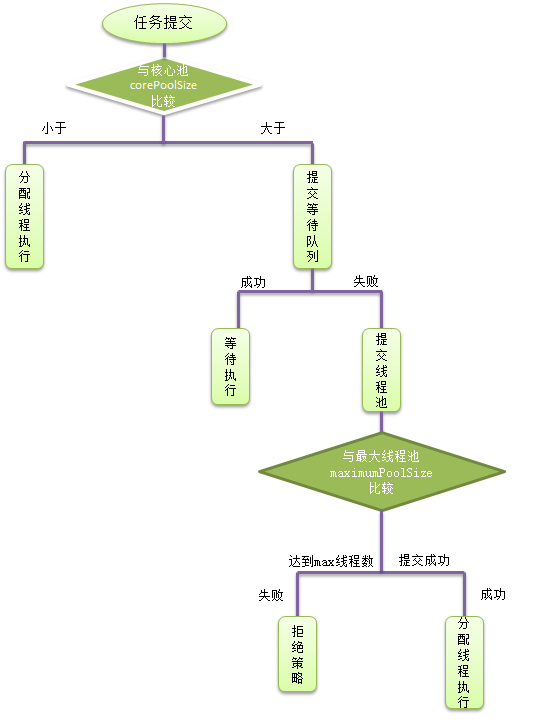线程池优势
- 降低系统资源消耗,通过重用已存在的线程,降低线程创建和销毁造成的消耗;
- 提高系统响应速度,当有任务到达时,通过复用已存在的线程,无需等待新线程的创建便能立即执行;
- 方便线程并发数的管控。因为线程若是无限制的创建,可能会导致内存占用过多而产生OOM,并且会造成cpu过度切换(cpu切换线程是有时间成本的(需要保持当前执行线程的现场,并恢复要执行线程的现场))。
- 提供更强大的功能,延时定时线程池。
线程池参数
public class ThreadPoolExecutor extends AbstractExecutorService { public ThreadPoolExecutor(int corePoolSize, int maximumPoolSize, long keepAliveTime, TimeUnit unit, BlockingQueue<Runnable> workQueue, ThreadFactory threadFactory, RejectedExecutionHandler handler) { if (corePoolSize < 0 || maximumPoolSize <= 0 || maximumPoolSize < corePoolSize || keepAliveTime < 0) throw new IllegalArgumentException(); if (workQueue == null || threadFactory == null || handler == null) throw new NullPointerException(); this.acc = System.getSecurityManager() == null ? null : AccessController.getContext(); this.corePoolSize = corePoolSize; this.maximumPoolSize = maximumPoolSize; this.workQueue = workQueue; this.keepAliveTime = unit.toNanos(keepAliveTime); this.threadFactory = threadFactory; this.handler = handler; } }
corePoolSize(线程池基本大小):当向线程池提交一个任务时,若线程池已创建的线程数小于corePoolSize,即便此时存在空闲线程,也会通过创建一个新线程来执行该任务,直到已创建的线程数大于或等于corePoolSize时。
maximumPoolSize(线程池最大大小):线程池所允许的最大线程个数。当队列满了,且已创建的线程数小于maximumPoolSize,则线程池会创建新的线程来执行任务。另外,对于无界队列,可忽略该参数。
keepAliveTime(线程存活保持时间):当线程池中线程数大于核心线程数时,线程的空闲时间如果超过线程存活时间,那么这个线程就会被销毁,直到线程池中的线程数小于等于核心线程数。
workQueue(任务队列):用于传输和保存等待执行任务的阻塞队列。
threadFactory(线程工厂):用于创建新线程。threadFactory创建的线程也是采用new Thread()方式,threadFactory创建的线程名都具有统一的风格:pool-m-thread-n(m为线程池的编号,n为线程池内的线程编号)。
handler(线程饱和策略):当线程池和队列都满了,再加入线程会执行此策略。
任务缓存队列
阻塞队列可以保证任务队列中没有任务时阻塞获取任务的线程,使得线程进入wait状态,释放cpu资源。当队列中有任务时才唤醒对应线程从队列中取出消息进行执行。使得在线程不至于一直占用cpu资源。workQueue的类型为BlockingQueue<Runnable>,通常可以取下面三种类型:
- 有界任务队列ArrayBlockingQueue:基于数组的先进先出队列,此队列创建时必须指定大小;
- 无界任务队列LinkedBlockingQueue:基于链表的先进先出队列,如果创建时没有指定此队列大小,则默认为Integer.MAX_VALUE;
- 直接提交队列synchronousQueue:这个队列比较特殊,它不会保存提交的任务,而是将直接新建一个线程来执行新来的任务。
拒绝策略
- AbortPolicy:丢弃任务并抛出RejectedExecutionException
- CallerRunsPolicy:只要线程池未关闭,该策略直接在调用者线程中,运行当前被丢弃的任务。显然这样做不会真的丢弃任务,但是,任务提交线程的性能极有可能会急剧下降。
- DiscardOldestPolicy:丢弃队列中最老的一个请求,也就是即将被执行的一个任务,并尝试再次提交当前任务。
- DiscardPolicy:丢弃任务,不做任何处理。
线程池流程

线程工厂类Executors
Java通过Executors提供四种线程池:
1.newFixedThreadPool
创建一个定长线程池,可控制线程最大并发数,超出的线程会在队列中等待。
public static ExecutorService newFixedThreadPool(int nThreads) { return new ThreadPoolExecutor(nThreads, nThreads,0L, TimeUnit.MILLISECONDS,new LinkedBlockingQueue<Runnable>()); }
2.newSingleThreadExecutor
创建一个单线程化的线程池,它只会用唯一的工作线程来执行任务,保证所有任务按照指定顺序(FIFO, LIFO, 优先级)执行。
public static ExecutorService newSingleThreadExecutor() { return new FinalizableDelegatedExecutorService (new ThreadPoolExecutor(1, 1,0L, TimeUnit.MILLISECONDS,new LinkedBlockingQueue<Runnable>())); }
3.newCachedThreadPool
创建一个可缓存线程池,如果线程池长度超过处理需要,可灵活回收空闲线程,若无可回收,则新建线程。
public static ExecutorService newCachedThreadPool() { return new ThreadPoolExecutor(0, Integer.MAX_VALUE,60L, TimeUnit.SECONDS,new SynchronousQueue<Runnable>()); }
4.newScheduledThreadPool
创建一个定长线程池,支持定时及周期性任务执行。
public static ScheduledExecutorService newScheduledThreadPool(int corePoolSize) { return new ScheduledThreadPoolExecutor(corePoolSize); } public ScheduledThreadPoolExecutor(int corePoolSize) { super(corePoolSize, Integer.MAX_VALUE, 0, NANOSECONDS,new DelayedWorkQueue()); }